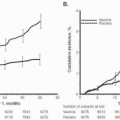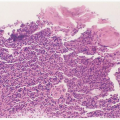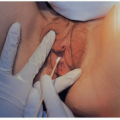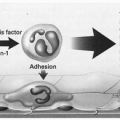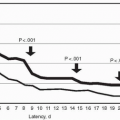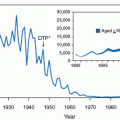Natural Penicillins
The common natural penicillins are penicillin G and penicillin V (penicillin phenoxymethyl). Penicillin G is available as penicillin G potassium, penicillin G sodium, penicillin G procaine, and penicillin G benzathine.
Spectrum of Activity
The penicillins are bactericidal antibiotics that interfere with cell wall formation by affecting the formation of the mucopeptide portion of the cell wall. Penicillin G is active against a wide range of bacteria, predominantly Gram-positive organisms. Among the Gram-positive, facultative, or aerobic cocci, penicillin G is highly active against group A streptococci. Although most Streptococcus pneumoniae strains remain extremely sensitive, resistant pneumococcal strains occur frequently in the United States. Group B α-hemolytic streptococci are 100% sensitive to penicillin G but are approximately 10-fold less sensitive than the group A streptococci. In addition, groups C and G β-hemolytic streptococci and the α-hemolytic streptococci such as Streptococcus viridans and nonenterococcal group D streptococci are sensitive to penicillin G. The anaerobic Gram-positive cocci such as Peptostreptococcus sp are highly susceptible to penicillin G. On the other hand, enterococcal group D streptococci are resistant to penicillin G, as are all Staphylococcus aureus strains, whose resistance is caused by β-lactamase (penicillinase) production.
Among Gram-positive bacilli, Corynebacterium diphtheriae, Bacillus anthracis, and many strains of Listeria monocytogenes are sensitive to penicillin G. Anaerobic Gram-positive spore-forming bacilli such as Clostridium perfringens and most other Clostridium sp are penicillin G-sensitive. In addition, penicillin G is active against most anaerobic non-spore-forming bacilli such as Actinomyces, Eubacterium, Bifidobacterium, Propionibacterium, and Lactobacillus species.
Among the Gram-negative cocci, Neisseria meningitides remains very sensitive to penicillin G. However, Neisseria gonorrhoeae susceptibility has dramatically decreased, so that penicillin has not been used to treat this organism for over 20 years. Gram-negative anaerobic cocci such as Veillonella sp are also sensitive to penicillin G.
Among Gram-negative bacilli, Escherichia coli, Proteus, Klebsiella, Enterobacter, Serratia, Salmonella, Shigella, Citrobacter spp and Pseudomonas aeruginosa, and other Pseudomonas species are all resistant to penicillin G. Although penicillin G is active against many Gram-negative anaerobes such as Fusobacterium and some Bacteroides species, resistant species are Bacteroides fragilis, Prevotella bivia (formerly Bacteroides bivius), and Bacteroides disiens.
Treponema pallidum is sensitive to penicillin G. The mycoplasmas, rickettsiae, fungi, and protozoa are completely penicillin resistant, whereas chlamydiae are relatively resistant.
The spectrum of activity of the phenoxypenicillins—penicillin V, phenethicillin, propicillin, and phenbenicillin—is generally similar to that described for penicillin G. However, penicillin G is more active against streptococci, pneumococci, and N. meningitides.
Dosage and Route
When oral therapy with penicillin is desired, penicillin V (penicillin phenoxymethyl), because of its greater acid stability than penicillin G, is the usual choice in a dosage of 250 to 500 mg (400,000 to 800,000 units) every 6 to 8 hours. Penicillin V may be given with meals. Based on kinetic studies, one recommended a dose in pregnancy of 1 million units every 6 hours instead of their usual dosing interval of every 8 hours.
Crystalline penicillin G is available to be administered intramuscularly or intravenously. When given intramuscularly, it reaches peak serum concentrations 15 to 30 minutes after injection; a dose of 1 million units results in a peak serum level of 12 μg/mL. By 3 to 4 hours, serum concentrations are negligible. Crystalline penicillin G is usually given in dosages ranging from 300,000 to 1,000,000 units every 6 hours by the intramuscular route, but it can be given as frequently as every 2 hours. Crystalline penicillin G may be administered intravenously by either intermittent bolus infusion or continuous infusion. The
intermittent infusion of high concentrations of penicillin G is generally preferred. A rapid infusion of 5 million units of crystalline penicillin G results in peak serum concentrations of 400 μg/mL within a few minutes. By 4 hours after injection, the serum concentration falls to 3 μg/mL. Intravenous therapy is administered in a dose of 1 million to 5 million units every 2 to 6 hours, depending on the severity of the clinical infection.
Repository penicillins for intramuscular injection are penicillin G procaine and penicillin G benzathine. With penicillin G procaine, peak serum levels occur 1 to 3 hours after injection, and detectable levels are usually present for up to 24 hours. The standard dose of penicillin G procaine is 600,000 to 1,200,000 units intramuscularly every 6 to 12 hours. When injected intramuscularly, penicillin G benzathine results in a slow release of penicillin, which lasts for 2 to 4 weeks. After injection of 2.4 million units of penicillin G benzathine, 0.12 μg/mL of penicillin can be detected 14 days after injection. The usual dose is 1.2 million to 2.4 million units, and the interval of dosing depends on the clinical indication.
Side Effects
Although penicillin is one of the least toxic antimicrobial agents, it is commonly responsible for hypersensitivity reactions. These hypersensitization reactions include rash, urticarial reactions, anaphylactic reactions, serum sickness, contact dermatitis, and angioedema. Local reactions may occur such as swelling, pain, and redness at the site of injection or phlebitis after intravenous infusion.
Direct penicillin toxicity may occur with massive doses (60 million to 100 million units daily). Neurologic toxicity with convulsions and coma may result, particularly in patients with renal insufficiency, underlying central nervous system (CNS) disease, or hyponatremia. Interstitial nephritis or hemolytic anemia may occur with large doses of penicillin G. Rarely, administration of penicillin G has been associated with development of thrombocytopenic purpura, glossitis, and stomatitis.
Penicillin V may result in gastrointestinal side effects such as nausea, vomiting, and diarrhea. Hypersensitivity reactions may occur as noted for penicillin G.
Cost
Penicillin G and penicillin V are inexpensive antimicrobial agents. Thus, for microorganisms susceptible to these agents, the penicillins remain the drug of choice.
Use in Pregnancy
Penicillin G rapidly crosses the placenta and achieves therapeutic levels in cord blood and, after several hours, in amniotic fluid. No adverse effects on the fetus have been demonstrated with the use of penicillin G, and this drug is considered safe to use during pregnancy. Similarly, penicillin V has not been linked with adverse fetal effects. Small amounts of either penicillin G or penicillin V are excreted in breast milk, and both are considered compatible with breast-feeding.
Metabolism
Penicillin G is primarily excreted in the urine. In patients with normal renal function, more than 70% of the injected dose is excreted within 6 hours. Ninety percent of penicillin G excretion occurs by tubular excretion and 10% by glomerular filtration. This renal tubular secretion can be partly blocked by probenecid, resulting in a doubling of serum levels of penicillin. Approximately 5% of penicillin G is excreted in the bile. The penicillin not excreted in urine or bile is inactivated in the liver, with penicilloic acid as the major end product. The phenoxypenicillins are also excreted
in urine and bile. During the first 6 hours after oral intake, 20% to 40% of the dose of penicillin V can be recovered from urine.
Penicillin G is widely distributed in the body. High concentrations of penicillin G are present in blood, liver, bile, skin, intestines, and kidneys. Low concentrations occur in joint fluid, pericardial fluid, and pleural fluid. Peritoneal fluid contains high concentrations. Small amounts of penicillin G are distributed to brain, nerve, dura, bone marrow, bone, pancreas, adrenal glands, or spleen. Whereas penicillin G poorly penetrates the blood-brain barrier in the presence of normal meninges, when the meninges are inflamed, cerebrospinal fluid (CSF) levels of penicillin G are adequate.
Indications in Obstetrics and Gynecology
Penicillin G is the drug of choice for infections caused by group A streptococci and for prevention and treatment of infections caused by group B β-hemolytic streptococci. Because of its activity against aerobic and anaerobic streptococci, Clostridium species, and many of the Bacteroides species, penicillin G was commonly used in combination with an aminoglycoside as initial therapy for mixed aerobic-anaerobic soft tissue pelvic infections. However, recognition of the role of penicillin-resistant anaerobes has resulted in a diminished role for penicillin G in polymicrobial infections.
When enterococcal infection is a concern, penicillin G should be combined with an aminoglycoside because penicillin plus an aminoglycoside has a synergistic effect on the enterococcus.
As described in
Chapter 5, penicillin G in the form of penicillin benzathine is the drug of choice for the treatment of syphilis.
Penicillin G is the drug of choice for the treatment of actinomycosis, which may be found associated with intrauterine device usage. Similarly, it is the drug of choice for most clostridial infections (except C. difficile).
Antistaphylococcal Penicillins
The emergence of β-lactamase-producing S. aureus led to major efforts for the development of antibiotics resistant to the hydrolysis of β-lactamase enzymes. This resulted in a large variety of semisynthetic penicillins derived from 6-amniopenicillanic acid. The narrow-spectrum penicillinase-resistant penicillins include methicillin, oxacillin, nafcillin, cloxacillin, dicloxacillin, and flucloxacillin.
Spectrum of Activity
In 1961, methicillin was the first antistaphylococcal penicillin introduced into clinical medicine. Although it is active against pneumococci and streptococci, its efficacy against these organisms is many-fold less than that of penicillin G. Methicillin is active against most strains of S. aureus, but increasingly, methicillin-resistant S. aureus (MRSA) has been reported. MRSA is resistant by virtue of altered penicillin-binding proteins. MSRA is also resistant to penicillin G, the cephalosporins, and other penicillinase-resistant penicillins such as nafcillin, oxacillin, cloxacillin, and dicloxacillin. MRSA had been associated predominantly with hospital-acquired infections, but in the last 10 years, MRSA infections have now been community acquired as well and appear in otherwise healthy pregnant women and newborns. The isoxazolyl penicillins—oxacillin, cloxacillin, and dicloxacillin—have a spectrum of activity similar to that of methicillin. Nafcillin also has a similar antibacterial spectrum. Its stability in the presence of staphylococcal penicillinase is comparable to that of methicillin but greater than that of the isoxazolyl penicillins.
Dosage and Route
Methicillin is administered only by the intravenous route. The dosage can be varied depending on the site and severity of the infection. For infections of moderate severity, 1 g every 4 hours is generally used, and for serious infections such as endocarditis, a dose of 2 g every 2 to 3 hours may be given. After an intravenous injection of 1 g of methicillin, a peak serum level of 60 μg/mL is obtained. There is a rapid fall in serum levels, to 7 μg/mL by 1 hour and less than 1 μg/mL by 2 to 3 hours. The peak level can be doubled by doubling the dose.
Although oral oxacillin is available, it is absorbed erratically. Oxacillin may be given in a dosage of 250 to 500 mg every 4 to 6 hours, intravenously or intramuscularly, for mild to moderate infections. The dosage for severe infections is 1 g intravenously every 4 to 6 hours. Peak serum levels after a single intramuscular injection of oxacillin (500 mg) reach 14 to 16 μg/mL.
Cloxacillin and dicloxacillin are analogs of oxacillin. They are acid stable and thus well absorbed after oral ingestion. After an oral dose of 500 mg of cloxacillin, a peak serum level of 8 μg/mL is reached in 30 to 60 minutes. Dicloxacillin produces serum levels that are twice as high as those of cloxacillin. Serum levels of flucloxacillin are similar to those seen with dicloxacillin. The usual oral adult dosage of these penicillins is 500 mg every 6 hours. For dicloxacillin, a dosage of 125 to 250 mg every 6 hours may suffice.
Oxacillin, cloxacillin, and flucloxacillin can be given intramuscularly or intravenously, although dicloxacillin can be given intramuscularly. For mild infections, 250 mg every 6 hours is recommended. For moderate infections, the usual dosage is 1 g every 4 hours, and in severe infections, this is increased to 2 g every 4 hours.
Nafcillin is poorly absorbed and is unreliable when used orally. It can be given either intramuscularly or intravenously. The usual adult dosage is 1 g every 4 hours but can be increased to 2 g every 4 hours for severe infections. After a 1-g intramuscular injection, a peak serum level of 8 μg/mL of nafcillin is reached in about 1 hour. By 6 hours, the level is 0.5 μg/mL.
Side Effects
Methicillin, isoxazolyl penicillins, and nafcillin are contraindicated in penicillin-allergic patients because they can produce any of the hypersensitivity reactions described for penicillin G. Methicillin has been associated with drug fever and leukopenia. In addition, interstitial nephritis may result from the use of large doses of intravenous methicillin. Most patients recover from the methicillin-associated interstitial nephritis after stopping the agent.
The isoxazolyl penicillins may produce nausea and diarrhea with oral administration. Oxacillin may cause fever, nausea, and vomiting in association with abnormal liver function test results. Neutropenia has been noted as well. With very large doses, neurotoxicity occurs, particularly in patients with impaired renal function.
Nafcillin has been reported to cause nephropathy and neutropenia on rare occasion.
Cost
The penicillinase-resistant penicillins are more expensive drugs than are penicillin G. They should be used only in the treatment of staphylococcal strains resistant to penicillin G.
Use in Pregnancy
All of the penicillinase-resistant penicillins are capable of crossing the placenta. No untoward effects on the fetus have been described.
Metabolism
Methicillin is excreted in urine, both by glomerular filtration and by tubular secretion. Up to 80% of an injected dose can be recovered from urine. A small percentage (2% to 3%) of the administered drug is excreted in bile. The unexcreted methicillin is inactivated in the body by the liver. Methicillin is widely distributed throughout the body.
Isoxazolyl penicillins are mainly excreted in the urine, with dicloxacillin and flucloxacillin present in larger amounts than cloxacillin, of which 30% of an oral dose is excreted in the urine. Oxacillin is excreted in smaller amounts than cloxacillin. Excretion occurs by glomerular filtration and tubular secretion. These penicillins are also excreted in the bile to a small extent. Inactivation of the isoxazolyl penicillins probably occurs in the liver.
After administration of nafcillin, 30% of the dose can be recovered from the urine. Between 5% and 10% of a dose is excreted in bile. The remainder of the nafcillin is inactivated in the liver. Nafcillin reaches high concentrations in the CSF of patients with normal meninges and in those with inflamed meninges.
Indications in Obstetrics and Gynecology
The penicillinase-resistant penicillins are indicated solely for the treatment of infections caused by S. aureus. Examples include wound and episiotomy infection, mastitis, endocarditis, osteomyelitis, and toxic shock syndrome. Because infections caused by MRSA now appear in the community and are not readily distinguishable from other infections, it is recommended that a specimen for culture and sensitivity be sent even from community-acquired infections. One characteristic of MRSA infections is that an inappropriate antibiotic has usually been chosen initially.
Aminopenicillins
The aminopenicillins are semisynthetic derivatives of 6-APS and include ampicillin, amoxicillin, and antibiotics structurally related to ampicillin-amoxicillin, such as epicillin, cyclacillin, hetacillin, pivampicillin, talampicillin, bacampicillin, and metampicillin.
Spectrum of Activity
Ampicillin and amoxicillin have identical spectra. They are active against most of the bacteria that are sensitive to penicillin G. However, they are also active against some of the Gram-negative bacteria that are resistant to penicillin G. Like penicillin G, they are bactericidal antibiotics that inhibit cell wall synthesis.
Against aerobic Gram-positive cocci, ampicillin is generally as effective as penicillin G. Thus, group A and group B β-hemolytic streptococci, most S. pneumoniae, and the β-hemolytic streptococci of the viridans group are susceptible. Nearly all S. aureus organisms are resistant to ampicillin. Unlike penicillin G, ampicillin is effective against enterococcal strains of the group D streptococci. The anaerobic Gram-positive cocci such as Peptostreptococcus species are almost always sensitive to ampicillin.
Among Gram-positive aerobic bacilli, C. diphtheriae, B. anthracis, and L. monocytogenes are generally susceptible to ampicillin. Ampicillin is active against anaerobic Gram-positive spore-forming bacilli such as clostridia and anaerobic Gram-positive non-spore-forming bacilli such as Actinomyces, Eubacterium, Bifidobacterium, Propionibacterium, and Lactobacillus species.
Ampicillin is effective against some of the Enterobacteriaceae. Although E. coli is often sensitive, increasing resistance by this organism has made ampicillin an unreliable empiric choice for therapy. Unless it is a β-lactamase-producing strain, Proteus mirabilis is susceptible to ampicillin. Enterobacter, Klebsiella, Serratia, Citrobacter, and indole-positive Proteus strains are generally resistant to ampicillin. Salmonellae are usually sensitive, but resistant strains have occurred. On the other hand, Shigella species tend to be resistant.
Among the other Gram-negative aerobic bacteria, P. aeruginosa is always resistant to ampicillin. Haemophilus influenzae type b was generally sensitive to ampicillin, but plasmid-mediated ampicillin resistance has occurred. Because of the prevalence of penicillinase-producing N. gonorrhoeae (PPNG) strains, ampicillin (like penicillin) has not been used to treat gonorrhea in over 20 years. N. meningitides organisms remain sensitive. Similar to the pattern with penicillin G, many of the Bacteroides and Fusobacterium species are ampicillin sensitive. The notable exceptions are B. fragilis group, P. bivia, and Prevotella disiens. Mycoplasmas and rickettsiae are ampicillin resistant and chlamydiae are relatively resistant, but Chlamydia trachomatis cervicitis may be treated with amoxicillin, which is an alternative treatment in pregnancy.
Dosage and Route
The usual oral dosage of ampicillin is 250 to 500 mg every 6 hours. After oral administration of 500 mg, peak serum levels of 3 μg/mL are obtained at approximately 2 hours, and the drug is still detectable at 6 hours. Doubling the dose results in a doubling of the serum level. Oral absorption of ampicillin is significantly lowered if it is taken with meals. For amoxicillin, the usual dosage is 250 mg, three times a day.
An intramuscular preparation of ampicillin is available but rarely necessary. The usual dosage is 0.5 to 1.0 g every 6 hours. After a 500-mg injection, a peak serum level of 10 μg/mL is achieved in 1 hour, and levels persist for 4 hours.
The usual intravenous dosage is 1 to 2 g every 4 to 6 hours by intermittent infusion, depending on the severity of the clinical infection.
Amoxicillin is significantly better absorbed than ampicillin when given orally, and peak serum levels are approximately 2 to 2.5 times those achieved with a similar dose of ampicillin. The usual adult dosage of amoxicillin is 250 to 500 mg every 6 to 8 hours.
Side Effects
Ampicillin and the other aminopenicillins may cross-react with other penicillins and therefore should not be used in patients with a history of penicillin allergy. Any of the hypersensitivity reactions described for penicillin G may occur with ampicillin. The incidence of rash in ampicillin users is much greater than that reported with use of penicillin G. Five percent to 7% of patients treated with ampicillin develop a diffuse macular rash. However, these rashes are specific for ampicillin and do not represent a true penicillin allergy.
Gastrointestinal side effects such as nausea and diarrhea occur commonly but are generally not serious. Because of their enhanced gastrointestinal absorption, the aminopenicillins,
except ampicillin, are associated with fewer gastrointestinal side effects. More rarely, pseudomembranous colitis has been reported with ampicillin use. Unusual side effects noted in ampicillin treatment include nephropathy, agranulocytosis, and encephalopathy.
Ampicillin may impair the absorption of oral contraceptives and thus can be associated with breakthrough bleeding. Monilia vaginitis may develop secondary to ampicillin suppression of the normal vaginal microflora.
Cost
Ampicillin is a relatively inexpensive antibiotic, in both oral and parenteral forms. For oral amoxicillin, the cost is similar. The other aminopenicillins are more costly than ampicillin, and the additional cost may limit their use.
Use in Pregnancy
Ampicillin has been used extensively in pregnancy. Because no adverse fetal effects have been associated with ampicillin, the drug is considered safe for use in pregnancy. In pregnant woman, serum levels of ampicillin are approximately 50% of those obtained in nonpregnant women. This is the result of the significant increases in plasma volume and renal clearance of ampicillin that occur in pregnancy. Shorter dosing intervals or an increased dose has been recommended.
Ampicillin rapidly crosses the placenta, and after a single maternal dose, peak cord blood levels are 40% of the peak maternal levels. In turn, amniotic fluid levels are initially lower than those in the umbilical cord but increase to therapeutic levels over several hours. Use of amoxicillin/ampicillin is compatible with breast feeding, and these drugs are excreted in small amounts of breast milk.
Experience with the aminopenicillins other than ampicillin/amoxicillin in pregnancy is limited, to date.
Metabolism
Like penicillin G, ampicillin is largely excreted in urine as the result of glomerular filtration and tubular secretion. After oral administration, 75% of a dose is excreted in the urine. The remainder of an ampicillin dose is either excreted in the bile or inactivated in the liver.
Ampicillin is evenly distributed throughout body tissues, with levels in the kidneys and liver being significantly greater than serum levels. Although only very low levels can be detected in normal CSF, high levels of ampicillin are achieved in the CSF with inflamed meninges.
Indications in Obstetrics and Gynecology
Ampicillin may be used in the therapy for asymptomatic bacteriuria, acute cystitis, and acute pyelonephritis in pregnant and nonpregnant women, provided there is demonstrated in vitro susceptibility of the infecting organism. Because of increasing resistance of E. coli, ampicillin should not be used by itself in the empiric treatment of urinary tract infection.
Although in the past ampicillin alone or in combination with an aminoglycoside was commonly used for the treatment of mixed aerobic-anaerobic soft tissue pelvic infections such as endomyometritis, pelvic cellulitis, or pelvic inflammatory disease (PID), the recognition of the need to provide therapy against Gram-negative anaerobes in such infections has resulted in a more widespread use of “triple therapy” (ampicillin, clindamycin, and gentamycin).
Ampicillin is an alternate to penicillin for prevention and treatment of group B streptococcal infections. Ampicillin is also the optimal drug for the treatment of L. monocytogenes infections.
Finally, ampicillin has been used effectively as a prophylactic antibiotic with cesarean sections and vaginal hysterectomy. Because of enhanced oral absorption, amoxicillin has replaced oral ampicillin in the treatment of UTIs.
Antipseudomonal Penicillins
The antipseudomonal group of penicillins include the carboxypenicillins—carbenicillin and ticarcillin—and the ureidopenicillin azlocillin. The major importance of these antimicrobial agents is their activity against Pseudomonas species. However, they are all susceptible to β-lactamase enzymes produced by Gram-negative and Gram-positive organisms.
Spectrum of Activity
The spectrum of activity of carbenicillin is similar to that of ampicillin, but it does possess activity against P. aeruginosa and certain indole-positive Proteus species. Carbenicillin is less active than ampicillin against the facultative streptococci. Klebsiella pneumoniae is resistant. At high concentrations, carbenicillin is also active against anaerobic bacteria including B. fragilis, although not to the extent of clindamycin, chloramphenicol, metronidazole, or cefoxitin. Carbenicillin acts synergistically with aminoglycosides to inhibit P. aeruginosa. This is clinically important because resistance to carbenicillin often develops among P. aeruginosa during therapy. The antibacterial spectrum of ticarcillin is similar to that of carbenicillin with the exception that it is 2 to 4 times more active against P. aeruginosa. However, strains of P. aeruginosa that are highly resistant to carbenicillin are also resistant to ticarcillin. Azlocillin is a ureidopenicillin whose main advantage is its significantly enhanced activity against P. aeruginosa, compared with that of carbenicillin or ticarcillin. All three of these agents are ineffective against β-lactamase-producing S. aureus.
Dosage and Route
Carbenicillin is not absorbed after oral administration and is available in intramuscular or intravenous forms. An oral form, carbenicillin indanyl sodium, is available but is useful only for UTIs because adequate serum concentrations are not achieved. For the treatment of systemic Pseudomonas infections or anaerobic infection, intravenous intermittent doses of carbenicillin (5 g every 3 to 4 hours) are required (total 30 to 40 g daily). Parenteral carbenicillin for Pseudomonas UTIs requires 1 to 2 g every 4 to 6 hours. The usual adult dosage for oral carbenicillin (provided as carbenicillin indanyl sodium) is 0.5 to 1.0 g every 6 hours.
After an intramuscular dose of 1 g, peak carbenicillin serum levels of 20 μg/mL are achieved in 1 hour, and no drug is detectable by 4 hours. Although these serum levels are inadequate for Pseudomonas or anaerobic infections in soft tissue, the urine levels reach 2,000 to 4,000 μg/mL, which are sufficient for the treatment of Pseudomonas UTI. With an intravenous infusion of 70 to 100 mg of carbenicillin per kilogram of body weight, serum levels of 150 to 200 μg/mL can be obtained; these levels are sufficient, in many instances, for the treatment of soft tissue Pseudomonas or anaerobic infections.
With ticarcillin, an adult dosage of 18 to 24 g per 24 hours is recommended for systemic
Pseudomonas infections or anaerobic infections; this is given as a 3-g dose every 3 to 4 hours. For treatment of UTIs, a dosage of 1 g every 6 hours is recommended. After a 1-g dose of ticarcillin intramuscularly, a mean peak serum level of 35 μg/mL is achieved in 1 hour, and by 6 hours, it is 6 μg/mL. After a 3-g intravenous
infusion, mean serum levels postinfusion are 239 μg/mL, and at 4 hours, they are 94 μg/mL.
Side Effects
Carbenicillin, ticarcillin, and azlocillin may provoke any of the hypersensitivity reactions that occur with penicillin G. High doses of carbenicillin may result in neurotoxicity. Each gram of carbenicillin contains 4.7 mEq of sodium. With the use of the required large dosage of 30 to 40 g per day, the potential for sodium overload may occur in patients with cardiac or renal disease. In addition, hypokalemia may occur as a result of this sodium overload. Finally, carbenicillin rarely is associated with bleeding as the result of diminished platelet adhesiveness.
In high doses, ticarcillin also may result in neurotoxicity, electrolyte disturbances similar to those described with carbenicillin, and altered platelet function. The lower required dose of ticarcillin (compared with that of carbenicillin) is associated with a lower sodium load and less platelet dysfunction.
Cost
The antipseudomonal penicillins are costly antimicrobial agents because of the large doses required.
Use in Pregnancy
Carbenicillin, ticarcillin, and azlocillin have not been used extensively during pregnancy. Like other penicillins, they are most likely safe to use during pregnancy. However, they should be used in pregnant women only when no safe alternative is available.
Metabolism
Carbenicillin is excreted via the kidney, with about 95% of a parenteral dose excreted into the urine during the first 6 hours after administration. It is excreted via glomerular filtration and tubular secretion. A small amount (less than 1%) of carbenicillin is excreted in the bile or inactivated in the liver. Similarly, ticarcillin and azlocillin are also primarily excreted via the kidneys.
Indications in Obstetrics and Gynecology
The clinical role for carbenicillin and ticarcillin in obstetrics and gynecology is now very limited. Although clinical studies have demonstrated relatively good efficacy with these agents (as single agents or in combination with aminoglycosides) in the treatment of mixed aerobic-anaerobic soft tissue infections of the pelvis, the introduction of the ureidopenicillins, mezlocillin and piperacillin, into clinical practice has significantly reduced their usefulness.
Although Pseudomonas infections of soft tissue are rare on obstetric and gynecologic services, when these infections do occur, azlocillin is an appropriate therapeutic agent. Its major advantage over aminoglycosides is a decreased potential for nephrotoxicity or ototoxicity. For serious Pseudomonas infection, azlocillin should be combined with an aminoglycoside.
Extended-Spectrum Penicillins
Ureidopenicillins, such as mezlocillin (Mezlin) and piperacillin (Pipracil), have replaced the carboxypenicillins (carbenicillin and ticarcillin). Compared with carbenicillin and ticarcillin, the ureidopenicillins have extended coverage against the Enterobacteriaceae, a diminished sodium load, and increased bioavailability in CSF, amniotic fluid, and cord blood. In addition, they provide increased activity against many aerobic and anaerobic Gram-positive cocci, including enterococci.
Spectrum of Activity
Piperacillin is active against most clinically important Gram-negative facultative bacteria, particularly indole-positive Proteus species, Klebsiella, many Serratia marcescens, and P. aeruginosa; E. coli, P. mirabilis, Enterobacter, Citrobacter, Salmonella, and Shigella species are sensitive to low concentrations of piperacillin. Piperacillin demonstrates activity against Gram-positive aerobic bacteria, including the enterococcus. In addition, virtually all clinically important anaerobes, including B. fragilis and P. bivia, are sensitive to piperacillin.
The major defect in the spectrum of these agents is lack of coverage for S. aureus, 10% of E. coli, and some Klebsiella species (particularly with piperacillin, which covers only half of Klebsiella strains).
Dosage and Route
Piperacillin (Pipracil) is available for intramuscular or intravenous (preferred) administration. The usual adult dosage is 3 to 4 g every 4 to 6 hours as an intravenous infusion (total, 12 to 18 g per day). After a 30-minute intravenous infusion of 4 g of piperacillin, peak serum levels of 215 μg/mL are reached; by 1 hour, the level is 105 μg/mL, and it falls to 15μg/mL by 4 hours.
Side Effects
As with other penicillins, mezlocillin and piperacillin have been associated with hypersensitivity reactions, nausea, diarrhea, CNS irritability with large doses, and local reactions such as phlebitis.
A major advantage of mezlocillin and piperacillin over carbenicillin and ticarcillin is a significant decrease in sodium load. The ureidopenicillins contain 1.85 mEq/g of sodium, compared with 5.23 mEq/g for carbenicillin and 5.20 mEq/g for ticarcillin. This dramatically reduces the risk of congestive heart failure in patients with cardiovascular compromise.
Cost
Both mezlocillin and piperacillin are expensive antimicrobial agents because of the need for large doses, frequent intravenous administration, and a moderately expensive per-gram cost.
Use in Pregnancy
Because of altered protein binding, the ureidopenicillins can enter cord blood and amniotic fluid in therapeutic concentrations. Experience with these agents in pregnancy is very limited. As penicillins, they are probably safe for use during pregnancy, but long-term follow-up studies are unavailable.
Metabolism
Like other penicillins, both mezlocillin and piperacillin are primarily excreted by the kidneys. Approximately 55% of a mezlocillin dose appears in urine within 6 hours, and 26% is excreted in the bile. For piperacillin, nearly 80% of a dose is excreted in urine within 24 hours. Excretion also occurs via the biliary route for piperacillin. Both mezlocillin and piperacillin are widely distributed throughout body tissues. Although little of either drug penetrates the CSF in normal
patients, mezlocillin and piperacillin both achieve satisfactory levels in the CSF with inflamed meninges.
Indications in Obstetrics and Gynecology
Clinical investigations have confirmed the efficacy of these agents in the treatment of mixed pelvic infections with clinical cure rates usually, but not always, similar to those achieved using standard regimens such as clindamycin plus gentamicin. These results suggest mezlocillin and piperacillin can be used as reasonable single-agent therapy for many polymicrobial infections in obstetrics and gynecology. Yet, they have not been evaluated as thoroughly as other regimens (e.g., clindamycin-gentamicin, and cefoxitin, or cefotetan).
Penicillin-β-Lactamase Inhibitor Combinations
This approach to developing new antimicrobial agents that are resistant to degradation by β-lactamase enzymes involves developing compounds that inhibit these enzymes and combining them with older β-lactam antibiotics. This results in an enhanced spectrum of activity against a wide variety of aerobic and anaerobic bacteria. Three enzyme inhibitors, clavulanic acid, sulbactam, and tazobactam, have been developed, and their combination with penicillins has led to the introduction of clinically available agents: amoxicillin-clavulanic acid (Augmentin), ticarcillin-clavulanic acid (Timentin), sulbactam-ampicillin (Unasyn), and piperacillin-tazobactam (Zosyn).
Amoxicillin-Clavulanic Acid (Augmentin)
The addition of clavulanic acid, a suicide inhibitor of β-lactamases, to amoxicillin has resulted in an antimicrobial agent (Augmentin) that has a markedly increased spectrum of activity against a wide variety of aerobic and anaerobic bacteria. Augmentin has demonstrated success in the treatment of skin infections caused by β-lactamase-producing S. aureus, otitis media caused by H. influenzae, UTIs caused by β-lactamase-producing E. coli and Klebsiella, and PPNG.
However, it is available only as an oral agent. Augmentin plus doxycycline is suggested as an alternative oral regiment for PID, but its use may be limited by a high incidence of nausea and vomiting.
Ticarcillin-Clavulanic Acid (Timentin)
Timentin is the combination of ticarcillin (3 g) and clavulanic acid (100 mg). The addition of clavulanic acid, a β-lactamase inhibitor, to ticarcillin resulted in a combination compound that has markedly enhanced activity. Compared with ticarcillin alone, Timentin has increased activity against S. aureus, E. coli, Klebsiella, B. fragilis, and other β-lactamase-producing Bacteroides. Timentin has demonstrated excellent in vitro activity against the B. fragilis group of organisms, which was equivalent to that of imipenem. However, enterococci and MRSA remain relatively resistant.
The pharmacology of ticarcillin is not significantly altered by the addition of clavulanic acid and thus is similar to that discussed already. Both drugs have a serum half-life of about 1 hour after intravenous infusion. Sixty percent to 90% of ticarcillin and 35% to 45% of clavulanic acid are excreted unchanged in the urine. Renal insufficiency leads to accumulation, so dosage adjustment is necessary for patients with renal impairment. After intravenous infusion, both ticarcillin and clavulanic acid are widely distributed, with peak serum levels of 400 μg/mL for ticarcillin and 11 μg/mL for clavulanic acid. The dosage of Timentin (3 g of ticarcillin and 100 mg of clavulanic acid) is every 4 to 6 hours, depending on the severity of infection. This combination can inactivate aminoglycosides and should not be infused at the same time as an aminoglycoside.
Side effects are rare and usually mild. Among the most common are phlebitis, rash, diarrhea, mild elevations in liver function test results, and, rarely, hematologic abnormalities such as eosinophilia, leukopenia, thrombocytopenia, or anemia.
The cost per day for Timentin (3.1 g every 6 hours) is high. In comparative studies, Timentin was found to be as effective as clindamycin-gentamicin. These results make Timentin a reasonable choice for many polymicrobial infections, but there has been more variability in cure rate than is seen with comparable regimens.
Ampicillin-Sulbactam (Unasyn)
The addition of sulbactam to ampicillin significantly extended the antibacterial spectrum of ampicillin to include β-lactamase-producing strains of H. influenzae, N. gonorrhoeae, many anaerobes (including B. fragilis, B. bivius, and B. disiens), E. coli, Klebsiella, Enterobacter aerogenes, S. aureus, and S. epidermidis. However, ampicillin-sulbactam is not active against P. aeruginosa, Enterobacter cloacae, or Serratia species.
Administration of ampicillin and sulbactam together has no effect on the pharmacokinetics of these agents. The serum half-life for both drugs is approximately 1 hour. After intravenous infusion, ampicillin and sulbactam are widely distributed, and after a 500-mg infusion of each agent, serum levels rapidly peak at about 30 μg/mL for ampicillin and 43 μg/mL for sulbactam. Eighty-five percent of both drugs is excreted in urine within 24 hours. Small amounts of both drugs appear in breast milk. Ampicillin-sulbactam is available as 1 g of sulbactam to every 2 g of ampicillin. The usual dosage is 0.5 to 1 g of sulbactam plus 1 to 2 g of ampicillin every 6 hours. As with ampicillin itself, the kinetics of ampicillin-sulbactam is altered in pregnancy. There is more rapid elimination and a shorter serum half-life.
The most common side effects have generally been nausea, vomiting, diarrhea, or allergic reactions. Minor elevations in liver function test results have been infrequently reported.
Based on the efficacy in clinical trials and the moderate cost, ampicillin-sulbactam is also a reasonable choice for treatment of polymicrobial infections. In combination with doxycycline, it is one of the alternative parenteral CDC regimens for PID. Among the penicillin β-lactamase combinations, it is the most widely studied.
Piperacillin-Tazobactam (Zosyn)
Another combination is piperacillin-tazobactam (Zosyn). Tazobactam is also an irreversible β-lactamase inhibitor. In a large multicenter comparative trial, Zosyn (3 g of piperacillin and 375 mg of tazobactam) compared favorably with clindamycin-gentamicin in various pelvic infections.




